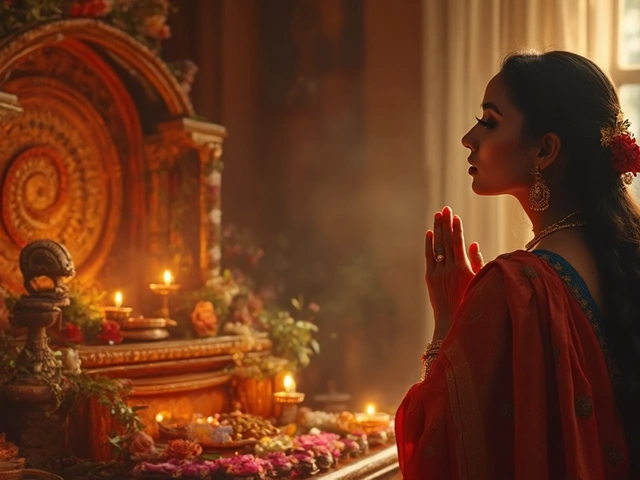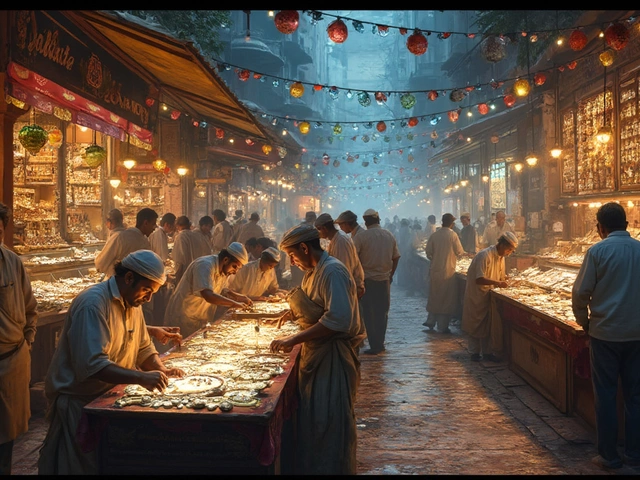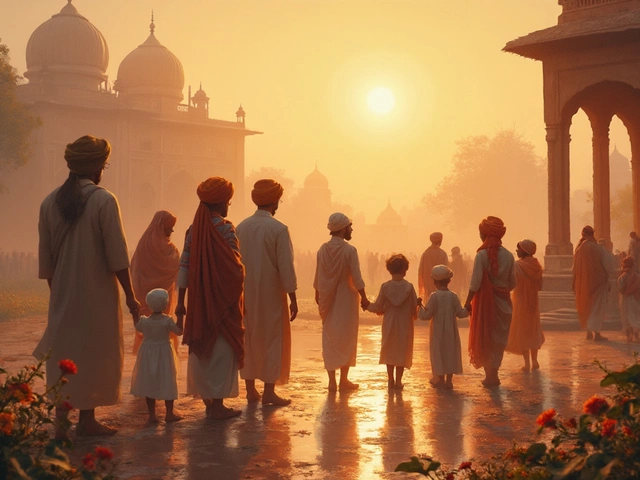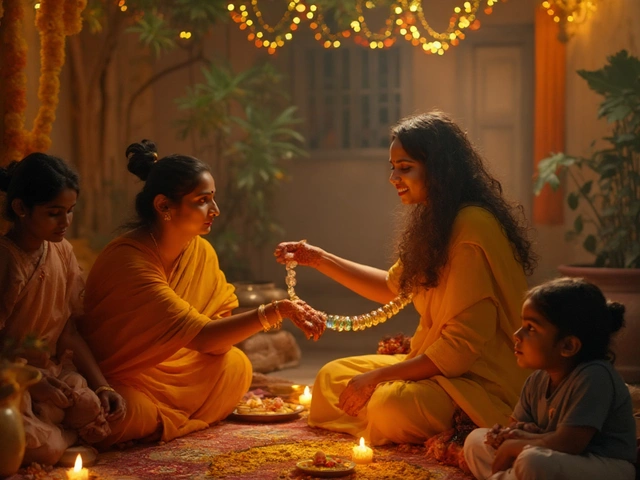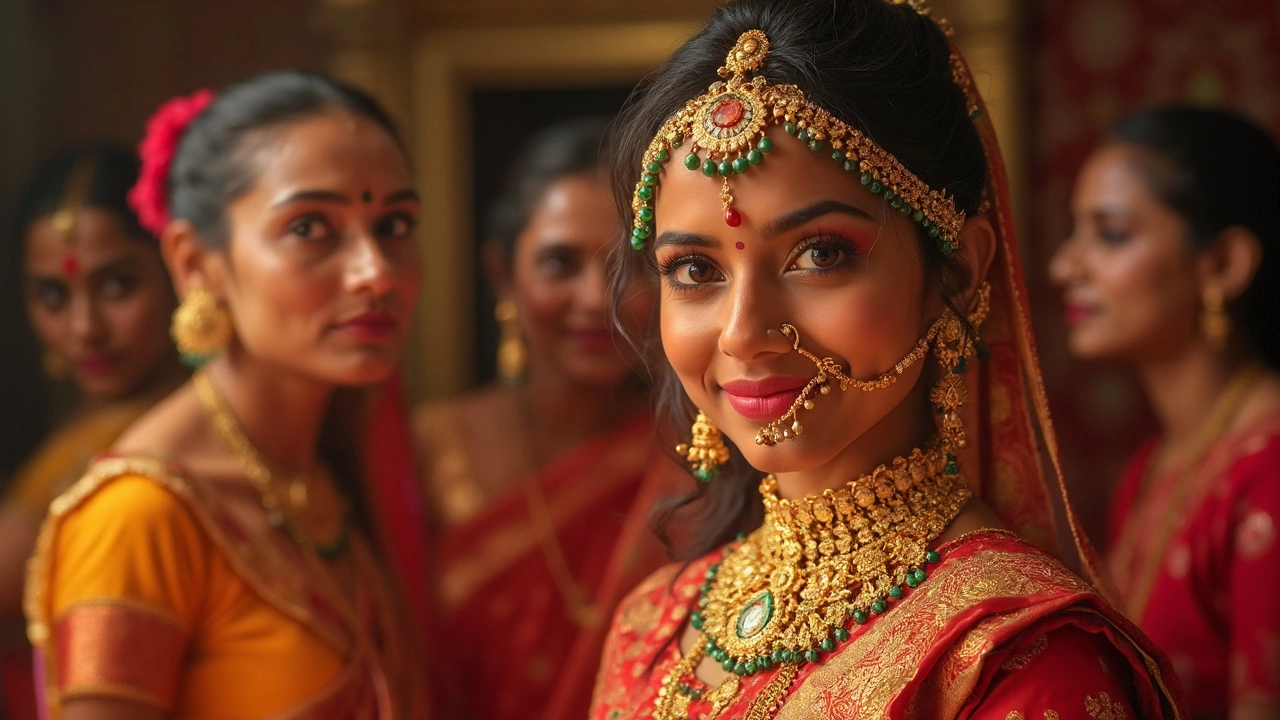
Walk into any big fat Indian wedding today, and chances are you’ll spot someone wearing temple jewellery. Those chunky gold necklaces with goddess pendants and bold carvings? They’re not just for grandmas or classical dancers anymore. More and more people—yes, even younger folks—want that royal, old-school look, but with a twist that fits into today’s world.
If you’re wondering why temple jewellery is suddenly on every bride, influencer, and even in casual get-togethers, you’re not alone. Part of its charm is the rich history (these pieces started out in South Indian temples centuries ago), but the real surprise is how versatile they’ve become. Even a basic kurta or jeans can look so much more put together with a statement temple choker or jhumkas.
Here’s what’s really happening: designers are giving ancient designs an update, mixing old motifs with lighter metals, colored stones, or quirky shapes. So, you don’t have to go full traditional or wear a saree to pull these off. And if you’re smart about how you shop and care for these beauties, they last for generations—trust me, nothing impresses aunties (or, honestly, my son Eamon) like a well-kept piece with a story.
- The Roots of Temple Jewellery
- Current Trends and Who’s Wearing It
- Not Just for Brides: Everyday Styling
- Mixing Modern and Traditional
- Tips on Buying Authentic Pieces
- Caring for Your Temple Jewellery
The Roots of Temple Jewellery
Temple jewellery isn’t just a fancy style—it’s packed with history. It first showed up more than 500 years ago in South India, especially in places like Tamil Nadu and Kerala. Temple jewellery India was made for gods and goddesses, not people. Priests would dress up temple statues during festivals and rituals using pure gold pieces which had lifelike carvings of Lakshmi, Ganesh, and other deities.
This style didn’t stay behind closed doors for long. Dancers in the famous Bharatanatyam and Kuchipudi styles began wearing these pieces on stage centuries back, since the jewellery was considered pure and connected to tradition. The designs weren’t just about bling—they often had symbols for luck, power, and protection. That’s why temple pendants and harams (the long, chunky traditional necklaces) are always center stage in traditional dance costumes.
According to jewellery historian Dr. Usha Balakrishnan, temple jewellery "reflects the deep-rooted connection between art, devotion, and craftsmanship in India."
Here’s a quick look at the main features that set temple jewellery India apart:
- Made from pure gold (sometimes silver for less pricey ones).
- Loaded with carvings of gods, goddesses, peacocks, elephants, and lotuses.
- Handcrafted using age-old techniques passed down through families.
- Decorated with red, green, and white stones (like rubies or uncut diamonds), giving that iconic, time-tested look.
| Traditional Origin | Typical Motifs | Main Materials |
|---|---|---|
| Tamil Nadu, Kerala | Deities, peacocks, lotuses | Gold, semi-precious stones |
Temple jewellery went from sacred use in South India jewellery culture to something you’ll find in families who pass it from one generation to the next. Ask around in Chennai, and someone will probably show you a piece their grandmother wore at her wedding. That’s the legacy that still pulls people in today.
Current Trends and Who’s Wearing It
Right now, temple jewellery India is having a serious moment. Just scroll through any major wedding photographer’s Instagram feed from the past year. What do you see? Brides, obviously, but also bridesmaids, moms, and sometimes even grooms in sherwanis sporting a temple pendant brooch. These pieces are not just showing up in the usual South Indian ceremonies. You’ll spot them at North Indian, Bengali, and even fusion weddings. That’s a big shift from a decade ago, when temple jewellery was pretty much a South-exclusive.
Bollywood and Tollywood stars are a huge reason for this jump in popularity. When Deepika Padukone wore temple-style chandbalis in ‘Padmaavat’ or Sai Pallavi paired a chunky Lakshmi necklace with a simple saree in movies, searches for "temple jewellery trend" spiked. Designers like Sabyasachi and Kalyan Jewellers are putting out entire wedding collections around these looks.
| Who’s Wearing It? | Occasions |
|---|---|
| Brides & Families | Weddings, Engagements |
| Film & TV Celebs | On-screen, Award Shows |
| Young Professionals | Festivals, Office Parties |
| Influencers/Blogger | Photoshoots, Social Media |
Here’s what’s trending in traditional Indian jewellery right now:
- Layered temple necklaces stacked with pearls or gemstones for a dramatic effect.
- Jhumkas and temple-style ear cuffs with colored stones. Easy to pair with anything, from lehengas to western dresses.
- Temple jewellery India with antique finishes—oxidized gold is a favorite—popping up in store windows all over Chennai, Hyderabad, and even online boutiques.
- Minimal temple pendants for casual wear. Think dainty Lakshmi or Ganesha motifs, good for daily use and work meetings.
What’s really cool is spotting someone at a regular birthday party or work event mixing a simple chain and small temple pendant with western workwear. Honestly, you don’t even have to wait for a big festival to pull these off anymore. That’s the biggest signal—temple jewellery trend is officially out of the box and everywhere you look.
Not Just for Brides: Everyday Styling
Who says temple jewellery India only shines at weddings? It’s popping up everywhere now, from daily office outfits to casual Sunday brunches. Now, more than ever, people want statement pieces that don’t feel over the top. You don’t need a sari or heavy silk to rock these. A simple pendant with a goddess motif, a pair of small jhumkas, or a delicate bangle is all it takes.
Take the classic Lakshmi coin necklace. Pair it with a solid-color kurta or even a plain T-shirt and jeans—it instantly attracts compliments. Designers like Sabyasachi and Anita Dongre are really pushing this trend too. They’ve brought mini-temple motifs and lightweight styles for people who want that heritage look but without all the weight or cost. Even for men, a simple chain with a temple pendant can add character to any outfit.
How can you style temple jewellery every day without looking like you’re heading to a wedding?
- Keep it minimal. Wear one standout piece—like big earrings or a bold ring—and let the rest be simple.
- Mix with modern wear. Don’t save your temple jhumkas for Indian outfits only. Pair them with Western dresses or even a jacket.
- Opt for silver or antique finishes if you want something more understated compared to yellow gold.
- Layer thin chains or bracelets with daily-wear watches or stack them for a trendy vibe.
These days, you’ll notice college students and working professionals sliding on temple-inspired studs or cuffs for a subtle punch. Here’s an interesting stat: A 2024 market report by Indian Jeweller magazine pointed out that demand for lightweight temple jewellery grew by 43% in the last three years and a chunk of buyers were women under 35. Clearly, it’s not a trend reserved for big events anymore.
Want to make your jewellery last and still keep the look fresh? Stick to authentic pieces or good-quality imitation. Avoid sprays and creams directly on metal, and gently clean with a soft cloth so those goddess faces stay sharp. Temple jewellery isn’t just about tradition; it’s about making it your own, every single day.
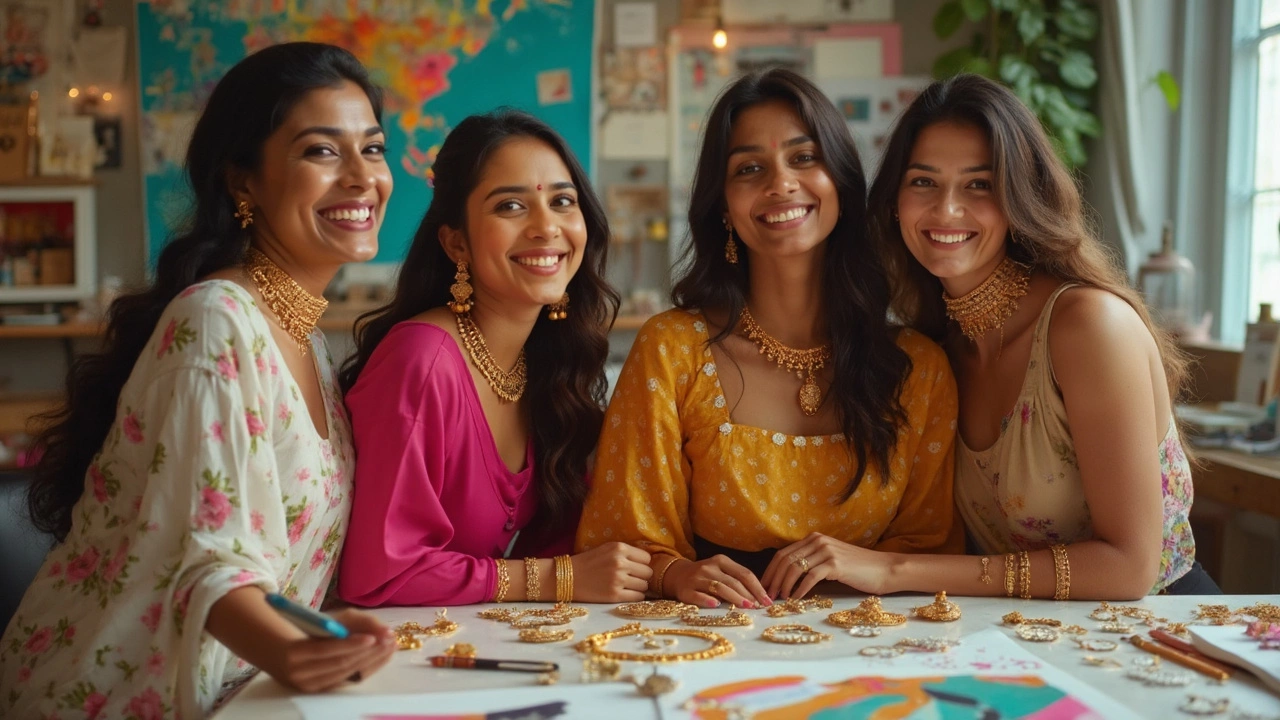
Mixing Modern and Traditional
Here’s something wild—just five years ago, temple jewellery India was mostly seen at classical dance shows and heavy bridal looks. Today, it’s everywhere, and the real magic is in how folks are mixing old-school designs with a modern touch. Modern Indian designers like Sabyasachi and Anita Dongre, for example, are taking classic motifs—like Lakshmi coins, peacocks, or mango shapes—and using them in lighter, everyday-friendly pieces. So, you’re just as likely to see a stylish twenty-something at brunch rocking a chunky temple pendant with a plain T-shirt as you are to see it at a wedding.
One reason this shift is catching on: no one wants to feel overdressed or stuck wearing heavy jewellery only during rare special events. Newer temple jewellery styles use gold plating, semi-precious stones, and sometimes even silver or bronze, making them cheaper and easier to wear daily. Kalyan Jewellers did a survey in 2023 that found nearly 40% of younger buyers prefer temple jewellery styles that work with both ethnic and western outfits. That’s a massive swing compared to a decade ago!
| Jewellery Material | Typical Usage | Popularity (2023)* |
|---|---|---|
| 22K Gold Temple Jewellery | Weddings, festivals | 35% |
| Gold-Plated, Mixed Metals | Everyday, college, work | 45% |
| Silver/Imitation Temple Jewellery | Casual, fusion outfits | 20% |
*Based on sales data from select Indian metros.
If you want to pull this off, here are a few tricks that always work in real life:
- Pair a chunky temple necklace with a crisp white shirt for instant glam.
- Layer simple temple jewellery India chains over a summer dress to get that Indo-western vibe.
- Swap heavy earring-backings for lighter hooks on old jhumkas—it keeps your ears happy, and you still get the traditional look.
- Don’t be afraid of mixing metals—a bit of silver with gold is actually trending in Mumbai and Bangalore right now.
This isn’t about ditching tradition. Think of it as showing off your culture in a way that actually fits your life. If Eamon’s school event pops up out of the blue, I just grab a simple temple pendant and it works with anything. That’s the real win here: old designs, made practical for the way we actually live.
Tips on Buying Authentic Pieces
Shopping for real temple jewellery India can be tricky, especially since plenty of fakes and replicas crowd the market. Here’s what actually works if you want the genuine stuff and not something that flakes after one wedding season.
- Check the Gold Purity: Authentic temple jewellery is usually crafted in 22-karat gold. Look for the BIS hallmark or ask for a certificate. If the piece feels suspiciously light or the price seems too good to be true, it probably isn’t the real deal.
- Inspect the Craftsmanship: Original designs have sharp, detailed carvings—usually gods, goddesses, and traditional motifs. If the details look fuzzy or mold-printed, give it a miss. Skilled artisans from places like Kerala or Tamil Nadu still use old-school hand techniques.
- Find Trusted Sellers: Stick with well-known stores or certified online portals specializing in traditional Indian jewellery. Many reputable jewellers openly share the origin and details of each piece. Avoid “Instagram deals” unless you’ve double-checked their credentials.
- Ask the Seller Questions: Authentic pieces usually come with some backstory—where it was made, which artisan built it, and sometimes even some paperwork tracing its roots. If the seller has no idea, that’s a red flag.
- Spot the Right Stones: Real temple jewellery uses rubies, emeralds, pearls, or uncut diamonds (polki). Glass or plastic stones are a definite no.
For reference, here’s a snapshot of where you’ll usually find the best temple jewellery in India:
| City/Region | Specialty |
|---|---|
| Chennai | Antique designs, premium gold |
| Kochi | Gold filigree, intricate work |
| Hyderabad | Pearl-studded pieces, polki sets |
| Madurai | Goddess pendants, chunky necklaces |
The bottom line? Don’t rush a purchase. Authentic temple jewellery trend is all about quality and story—pick something that lasts, looks stunning, and might even become an heirloom in your family. You’re paying for artistry, not just gold by the gram.
Caring for Your Temple Jewellery
Temple jewellery isn’t just pretty, it’s an investment—sometimes even a family heirloom. Whether you picked up a gorgeous temple jewellery India set from a top jeweller or inherited something from grandma, you want it to last. But these pieces need a little TLC if you want them looking fresh every single time you wear them.
First off: never toss temple jewellery in with your other accessories. The gold plating, semi-precious stones, and intricate work can get scratched or tangled if you do. The safest bet? Store every piece in a soft cloth pouch, or if you’re extra cautious, a box lined with velvet. Moisture is the enemy here. Keep them away from places that get humid, like bathrooms or kitchen drawers, to prevent tarnishing.
When cleaning, stay clear of harsh chemicals or regular jewelry cleaners. Instead, a gentle wipe with a soft cotton cloth usually does the trick for basic dust. For grime in tiny corners, use a soft-bristled brush—think of an old baby toothbrush. If there’s stubborn dirt, a mild soap solution and quick dip (not soak!) can help, but always dry it right away. Be careful if your temple pieces have pearls or colored stones—water can loosen the glue or make colors fade.
- Put on your temple jewellery after finishing all makeup and hair sprays—these products can mess with the finish.
- Avoid wearing them during workouts, showers, or while doing chores. Sweat and soap are a big no-no.
- If you spot a broken clasp or missing stone, get it fixed sooner instead of later. Tiny problems can turn into big repairs.
Here’s a quick table that breaks down some common care tips for temple jewellery India pieces:
| Problem | How to Fix/Prevent |
|---|---|
| Tarnishing | Store in dry pouches, avoid humidity |
| Scratches | Keep each piece separate, use soft cloth wraps |
| Loose stones | Check and fix regularly by a jeweller |
| Loss of shine | Gentle cloth polishing after every use |
With these steps, your traditional Indian jewellery stays bright, safe, and ready to pull off any look—whether it’s a wedding or just a regular weekday. And if Eamon can manage to keep his hands off my stash, yours should be safe too!

